
1. Exploring the Role of VGA Ports in Modern IT Hardware
In the realm of modern IT hardware, discussions often gravitate towards cutting-edge technology and the latest interfaces that power our devices. Yet, nestled within this whirlwind of innovation, the VGA port remains a noteworthy component that showcases the evolution of connectivity. Despite being overshadowed by newer standards, the VGA port serves as a reminder of the foundations upon which our current technology stands.
The Visual Graphics Array (VGA) port was introduced in the late 1980s, revolutionizing how computers displayed visual content. As an analog interface, it allowed for the transmission of video signals and became a staple in connecting monitors and projectors in offices, classrooms, and homes. While we’ve since moved on to digital connections like HDMI and DisplayPort, the VGA port still holds significance in various aspects of IT and technology.
One of the key factors that contribute to the enduring presence of the VGA port is its compatibility with many legacy systems. For businesses and organizations that rely on older equipment, having VGA ports can be crucial for maintaining operational continuity. Transitioning away from established systems can be costly and cumbersome, which often leads to continued use of VGA hardware.
Additionally, the VGA port’s simplicity is one of its greatest assets. As a straightforward, plug-and-play connection, it requires minimal configuration and is widely supported across various devices. For IT professionals tasked with managing diverse hardware environments, this ease of use remains valuable, especially in situations where quick troubleshooting is essential.
In the educational sector, where many older projectors and displays still rely on VGA connections, educators continue to benefit from its functionality. The reliability of the VGA port means that teachers can focus on imparting knowledge rather than worrying about complicated setups. Moreover, many adapters and converters are available today that allow VGA to interface with modern HDMI displays, bridging the gap between the old and new.
While it may not boast the high-definition clarity of its successors, the VGA port embodies the IT landscape’s evolution—its persistence is a testament to its foundational role in technology. Recognizing its place in the history of information technology helps us appreciate how far we’ve come, and it reminds us that innovation often builds upon the frameworks established by earlier generations.
From ensuring compatibility with older technologies to its straightforward usability in various environments, the VGA port might not be the star of the show anymore, but it certainly deserves recognition for its contributions to the world of IT hardware. As we continue to explore the intricate web of modern technology, let us not forget the integral role that legacy interfaces like the VGA port play in shaping our paths forward.



